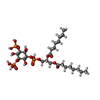+Search query
-Structure paper
| Title | Structural insights into the voltage and phospholipid activation of the mammalian TPC1 channel. |
|---|---|
| Journal, issue, pages | Nature, Vol. 556, Issue 7699, Page 130-134, Year 2018 |
| Publish date | Apr 5, 2018 |
 Authors Authors | Ji She / Jiangtao Guo / Qingfeng Chen / Weizhong Zeng / Youxing Jiang / Xiao-Chen Bai /   |
| PubMed Abstract | The organellar two-pore channel (TPC) functions as a homodimer, in which each subunit contains two homologous Shaker-like six-transmembrane (6-TM)-domain repeats. TPCs belong to the voltage-gated ion ...The organellar two-pore channel (TPC) functions as a homodimer, in which each subunit contains two homologous Shaker-like six-transmembrane (6-TM)-domain repeats. TPCs belong to the voltage-gated ion channel superfamily and are ubiquitously expressed in animals and plants. Mammalian TPC1 and TPC2 are localized at the endolysosomal membrane, and have critical roles in regulating the physiological functions of these acidic organelles. Here we present electron cryo-microscopy structures of mouse TPC1 (MmTPC1)-a voltage-dependent, phosphatidylinositol 3,5-bisphosphate (PtdIns(3,5)P)-activated Na-selective channel-in both the apo closed state and ligand-bound open state. Combined with functional analysis, these structures provide comprehensive structural insights into the selectivity and gating mechanisms of mammalian TPC channels. The channel has a coin-slot-shaped ion pathway in the filter that defines the selectivity of mammalian TPCs. Only the voltage-sensing domain from the second 6-TM domain confers voltage dependence on MmTPC1. Endolysosome-specific PtdIns(3,5)P binds to the first 6-TM domain and activates the channel under conditions of depolarizing membrane potential. Structural comparisons between the apo and PtdIns(3,5)P-bound structures show the interplay between voltage and ligand in channel activation. These MmTPC1 structures reveal lipid binding and regulation in a 6-TM voltage-gated channel, which is of interest in light of the emerging recognition of the importance of phosphoinositide regulation of ion channels. |
 External links External links |  Nature / Nature /  PubMed:29562233 / PubMed:29562233 /  PubMed Central PubMed Central |
| Methods | EM (single particle) |
| Resolution | 3.2 - 3.4 Å |
| Structure data | |
| Chemicals |  ChemComp-NAG:  ChemComp-NA:  ChemComp-EUJ: |
| Source |
|
 Keywords Keywords | MEMBRANE PROTEIN / Ion channel |
 Movie
Movie Controller
Controller Structure viewers
Structure viewers About Yorodumi Papers
About Yorodumi Papers








